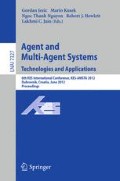Abstract
Many deaf people are using lip reading as a main communication fiorm. A viseme is a representational unit used to classify speech sounds in the visual domain and describes the particular facial and oral positions and movements that occur alongside the voicing of phonemes. A design tool for creating correct speech visemes is designed. It’s composed of 5 modules; one module for creating phonemes, one module for creating 3D speech visemes, one module for facial expression and modul for synchronization between phonemes and visemes and lastly one module to generate speech triphones. We are testing the correctness of generated visemes on Slovak speech domains. The paper descriebes our developed tool.
Access this chapter
Tax calculation will be finalised at checkout
Purchases are for personal use only
Preview
Unable to display preview. Download preview PDF.
References
Hrúz, M., Krňoul, Z., Campr, P., Muller Ludek, M.S.: Tovards Automatic Annotation of Sing Language Dictionarz Corpora. In: TDS Pilsen, pp. 331–339 (2011)
Cai, Q., Gallup, D., Zhang, C., Zhang, Z.: 3D deformable face tracking with a commodity depth camera. In: Daniilidis, K., Maragos, P., Paragios, N. (eds.) ECCV 2010, Part III. LNCS, vol. 6313, pp. 229–242. Springer, Heidelberg (2010)
Drahoš, P., Šperka, M.: Face Expressions Animation in e-Learning, http://lconf06.dei.uc.pt/pdfs/paper14.pdf
Albrecht, J.: Haber, and H.-P. Seidel. Speech Synchronization for Physicsbased Facial Animation. In: Skala, V. (ed.) Proc. 10th Int. Conf. on Computer Graphics, Visualization and Computer Vision (WSCG 2002), pp. 9–16 (2002)
Ma, J., Cole, R., Pellom, B., Ward, W., Wise, B.: Accurate visible speech synthesis based on concatenating variable length motion capture data. IEEE
Wang, A., Emmi, M., Faloutsos, P.: Assembling an expressive facial animation system. In: Sandbox 2007: Proceedings of the 2007 ACM SIGGRAPH Symposium on Video Games, pp. 21–26. ACM Press (2007)
Ezzat, T., Geiger, G., Poggio, T.: Trainable videorealistic speech animation. In: SIGGRAPH 2002: Proceedings of the 29th Annual Conference on Computer Graphics and Interactive Techniques, pp. 388–398. ACM Press (2002)
Cohen, M.M., Massaro, D.W.: Modeling coarticulation in synthetic visual speech. In: Magnenat Thalmann, N., Thalmann, D. (eds.) Models and Techniques in Computer Animation, pp. 139–156. Springer, Tokyo (1994)
Brand, M.: Voice puppetry. In: SIGGRAPH 1999: Proceedings of the 26th Annual Conference on Computer Graphics and Interactive Techniques, pp. 21–28. ACM Press/Addison-Wesley Publishing Co. (1999)
Kim, I.-J., Ko., H.-S.: 3d lip-synch generation with data-faithful machine learning. Computer Graphics Forum. In: EUROGRAPHICS 2007, vol. 26(3) (2007)
Bregler, C., Covell, M., Slaney, M.: Video rewrite:driving visual speech with audio. In: Computer Graphics, Proc. SIGGRAPH 1997, pp. 67–74 (1997)
Meadow-Orlans, K.P., Mertens, D.M., Marilyn, S.-L.: Parents and their Deaf Children. Gallaudet University Press, Washington D.C. (2003)
Munoz-Baell, I.M., Ruiz, T.M.: Empowering the deaf; let the deaf be deaf. Journal Epidemiol Community Health 54(1), 40–44 (2000)
Author information
Authors and Affiliations
Editor information
Editors and Affiliations
Rights and permissions
Copyright information
© 2012 Springer-Verlag Berlin Heidelberg
About this paper
Cite this paper
Pajorová, E., Hluchý, L. (2012). Correct Speech Visemes as a Root of Total Communication Method for Deaf People. In: Jezic, G., Kusek, M., Nguyen, NT., Howlett, R.J., Jain, L.C. (eds) Agent and Multi-Agent Systems. Technologies and Applications. KES-AMSTA 2012. Lecture Notes in Computer Science(), vol 7327. Springer, Berlin, Heidelberg. https://doi.org/10.1007/978-3-642-30947-2_43
Download citation
DOI: https://doi.org/10.1007/978-3-642-30947-2_43
Publisher Name: Springer, Berlin, Heidelberg
Print ISBN: 978-3-642-30946-5
Online ISBN: 978-3-642-30947-2
eBook Packages: Computer ScienceComputer Science (R0)

